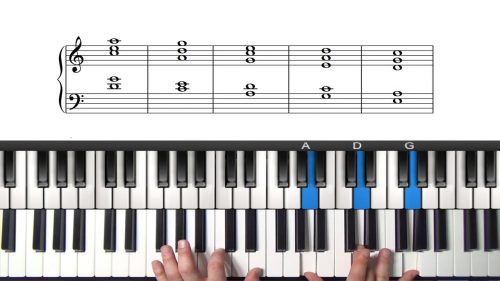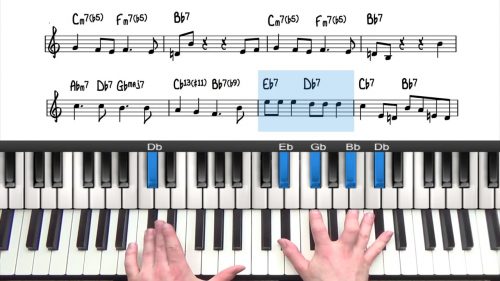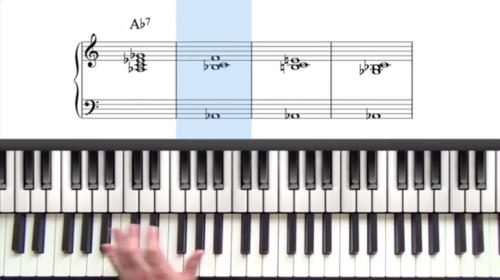“Emily” Jazz Standard Tutorial
In this lesson, we will create a solo piano arrangement of Johnny Mandel’s song ‘Emily’. This tune is played in many different keys, but for this lesson, we will create an arrangement in the key of G similar to the Bill Evans recordings of the tune.
The Bill Evans Arrangement
We will be using the Bill Evans’ arrangement as a guideline, as it is one of the most famous and influential recordings of the tune. Another great version to check out is the Stan Getz recording, also with Bill Evans on piano.
The Form & Modulations
“Emily” follows an A B A C form. The first A is in the key of G, The B Section modulates to the key of E, and the C part starts with the relative minor Em and then stays in the key of G throughout.
Practice Tips
-
Be sure to check out the vocal versions by Frank Sinatra and Tony Bennett.
-
When learning a new song, you should listen to as many vocal versions as possible.
-
It’s a good exercise to sing and learn the melody, and also for you to get familiar with the lyrics.







Jennifer Scott Trio, Vancouver BC
Beautiful Lori!
Hi Tuomo, is there anywhere that the Drop 2 is described. I’m not sure i understand what is going on using Drop 2 and it’s purpose. Thanks.
Hi Lonnie, the below message is from Tuomo…
—-
Drop 2 is a voicing technique where you drop the second note from the top of the voicing into the left hand.
In bar 13, I harmonise the stepwise melody with drop 2 voicings.
A 9:08, I play a 2nd inversion voicing for E-7 – I then drop the second to top note down into my left hand to play E-B-D-G – the E is the dropped note.
At 9:09, I play a diminished 7th chord C-Eb-F#-A but I drop the second to top note (F#) into my left hand to play a drop 2 diminished voicing.
At 9:10, I play a 3rd inversion E-7 – I drop the second to top note (G) into my left hand to get the drop 2 voicing: G-D-E-B
To summarise: drop 2 is an alternate way to voice the notes of a chord to achieve more interesting interval combinations. This is a characteristic sound of Bill Evans and can be heard in many of his recordings.
Check out Hayden’s course on block chords and drop2 voicings here: pianogroove.com/jazz-piano-lessons/block-chords-drop-2-voicings/ He starts with the theory, and then applies to the jazz standards.
Also I’m going to do a 5 minute masterclass about the so called ‘Barry Harris’ drop 2 voicings, where I also explain the major or minor chord/diminished chord movement with the melody.
Stay tuned for more!
Tuomo
Hi Lonnie! Sorry I didn’t answer earlier, if you have any further questions, don’t hesitate to ask! Also thank you Hayden for posting my answer earlier! -T
Thank you both (Tuomo and Hayden) for the help! It’s appreciated. The arrangement is beautiful.
My pleasure Lonnie. I’m glad to hear you liked the arrangement.
I had an inkling that you would enjoy Tuomo’s teaching – he places a lot of emphasis on functional harmonic analysis and I remembered that you like to look at tunes in this way.
Cheers :-)
Hayden
Hi, I am new to this community. This is a beautiful arrangement. Thank you! I appreciate the opportunity to ask the following questions. 1 . m 5. What is the thinking that allows you to decide to replace the D minor chord going to G7, to the Eminor passing tone progression? (I see that in m 13 it’s already identified as E minor but this is different). 2. m 11 -the melody note is an e (before measure 12)—You say to use B sus because of the melody note but in m 12 there’s a rest on beat 1 going to a B in the melody. Why do you use the E in the measure before to change the melody in m 12 and to change the chord to a Sus? I would be grateful to understand these small things better.
Hi Amy, thanks for writing!
Here answers to you questions:
Question 1. “m 5. What is the thinking that allows you to decide to replace the D minor chord going to G7, to the Eminor passing tone progression?”
There are many ways you can think of this measure.
First, E-7 is the same thing as Gmaj7, which is the key of the arrangement. So, you can think of the bar 5 as a bar of Gmaj7, after the A-7 D7, and before starting to move towards the IVth degree Cmaj7 (D-7 G7)
Also, you can think of the E-7 as a II chord of the E-7 A7 II V, which would resolve to the D-7. The II chords can be used without the V; this creates a relatively milder dominant tension, but still functions as one (see and play attachment).
Question 2. “m 11 -the melody note is an e (before measure 12)—You say to use B sus because of the melody note but in m 12 there’s a rest on beat 1 going to a B in the melody. Why do you use the E in the measure before to change the melody in m 12 and to change the chord to a Sus?”
I’m not quite sure I understood your question, but here some thoughts:
Yes, you are correct, the right exact chord symbol for the measure 12 would be B7sus. I wrote B7 just to clarify the II V connection.
Actually, I was thinking of the first beat on the measure 12 being E from the beginning of the bar, the written arrangement has the quarter pause for no reason actually.
Always remember to look at the bigger picture; The function of the bar 12 is to have a dominant chord that resolves to E-, the colors which we use are up to us to decide. In this case, I used sus color, mostly because of the melody note E, still the function stays the same.
In summary, always think that there are ONLY 3 different kinds of chords: tonics (I), subdominants (II) and dominants (V) (although I would even try to think II and V as the same thing, as the tension that needs to be resolved). Every note other than 1, 3 and 7 are colors, you could think of them as the sprinkles over your ice cream; ice cream is the main thing, but whatever you put on it is your own choice :)
Here some lessons that you might be interested in:
pianogroove.com/jazz-piano-lessons/advanced-improvisation-course/
pianogroove.com/live-seminars/harmonising-with-3-note-voicings/
Please let me know if this helped, or if you have any further questions!
-Tuomo
I really appreciate you responding so quickly and in detail. It is helpful to have both reasons for understanding your replacing the Dm7 bar–I can see D7 (m 4)could have resolved to GM (M5, Dm) and that Em can replace it. GM. I can see that Em-A7 (and not actually playing A7) can be inserted before any Dm- G7 measure. Got it. In m 12, I hear that B sus is a choice of sprinkles for B7 and the major focus is more that the B chord (dominant/sus) is going a 5th down to Em. I will check out your recommendations!